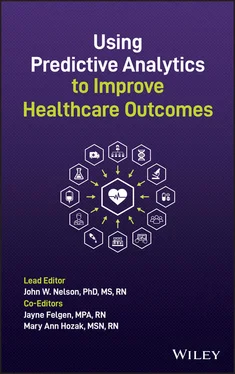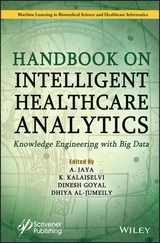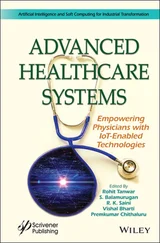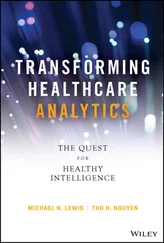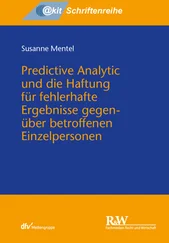Using Predictive Analytics to Improve Healthcare Outcomes
Здесь есть возможность читать онлайн «Using Predictive Analytics to Improve Healthcare Outcomes» — ознакомительный отрывок электронной книги совершенно бесплатно, а после прочтения отрывка купить полную версию. В некоторых случаях можно слушать аудио, скачать через торрент в формате fb2 и присутствует краткое содержание. Жанр: unrecognised, на английском языке. Описание произведения, (предисловие) а так же отзывы посетителей доступны на портале библиотеки ЛибКат.
- Название:Using Predictive Analytics to Improve Healthcare Outcomes
- Автор:
- Жанр:
- Год:неизвестен
- ISBN:нет данных
- Рейтинг книги:5 / 5. Голосов: 1
-
Избранное:Добавить в избранное
- Отзывы:
-
Ваша оценка:
- 100
- 1
- 2
- 3
- 4
- 5
Using Predictive Analytics to Improve Healthcare Outcomes: краткое содержание, описание и аннотация
Предлагаем к чтению аннотацию, описание, краткое содержание или предисловие (зависит от того, что написал сам автор книги «Using Predictive Analytics to Improve Healthcare Outcomes»). Если вы не нашли необходимую информацию о книге — напишите в комментариях, мы постараемся отыскать её.
Discover a comprehensive overview, from established leaders in the field, of how to use predictive analytics and other analytic methods for healthcare quality improvement. Using Predictive Analytics to Improve Healthcare Outcomes
before
proven in advance
Using Predictive Analytics to Improve Healthcare Outcomes
Using Predictive Analytics to Improve Healthcare Outcomes — читать онлайн ознакомительный отрывок
Ниже представлен текст книги, разбитый по страницам. Система сохранения места последней прочитанной страницы, позволяет с удобством читать онлайн бесплатно книгу «Using Predictive Analytics to Improve Healthcare Outcomes», без необходимости каждый раз заново искать на чём Вы остановились. Поставьте закладку, и сможете в любой момент перейти на страницу, на которой закончили чтение.
Интервал:
Закладка:
Step 15: Interface and Automate
Collecting data from a variety of software can take a lot of time, and it costs a lot of money for staff members to collect the data. These are compelling reasons to examine how technology can be used to automate the specified models developed to study the variable of interest. To examine outcomes in as close to real time as possible, interface the software and applications to one repository of data so the data can be examined as it comes in. Programs can be written to make the mathematical formula run every time one of the new variables comes into the dataset. A program can even be written for automatic respecification of the model as operations of clinical care improve. Manual respecification of a measurement model takes a lot of time, but if the program is set up to detect a fall in the explained variance for any variable, a program can be written that automatically reruns the correlations of all the variables in the model and then automatically builds a new model. Coefficients can be used to identify some specific aspects of how the newly added predictor variable is affecting the outcome variable. For example, if the variable of interest was CLABSI incidence, and the predictor variable is “central line type is causing infection,” the coefficients can identify what type of central line is causing infections, what unit/department it is most likely to occur in, and/or other specifics from other predictor variables in the model.
A program can be written for automatic respecification of the model as operations of clinical care improve.
Step 16: Write Predictive Mathematical Formulas to Proactively Manage the Variable of Interest
Over time, the analyses from models used to study how specific variables affect specific variables of interest will reveal trends that help us identify which variables pose the greatest and/or most immediate risks. Coding of the “variables of risk” into groups will allow you to use logistic regression or other procedures using odds ratios to automatically inform you of the probability that any given variable of risk (or group of risks) is actually causing an undesirable outcome. Real time analytics, made possible by the work you did in Step 15, will help you manage these risks before the undesirable outcome occurs. You might need to use more contemporary analytics, such as machine learning and simulation modeling for smaller samples. Machine learning and simulation modeling can also be used for testing reconfiguration of operations based on real‐time risk. For example, with staff schedules, machine learning and/or simulation modeling can be used to test how staffing ratios of RNs to nursing assistants (and other skill mixes) affect safety.
Summary 1: The “Why”
These steps have been used by this author repeatedly to save millions of dollars related to healthcare outcomes such as reduction of patient falls, reducing central line associated blood stream infections, and decreasing length of stay. With the advancement of mathematics and technology, the widespread use of predictive modeling for proactive management of outcomes in healthcare environments is happening now and will only increase. However, the biggest caution this author has is to not let machines do the interpretation and validation of the data that must necessarily be done by the people who are actually carrying out the work. Big data and machine learning can now quickly scan large datasets for patterns in the data, but it is clear to this author that the data must always be examined by a trained analyst and interpreted and validated by the people closest to the work.
Summary 2: The Even Bigger “Why”
We know that organizations want to provide the highest possible quality, safety, patient experience, and financial performance, and, ultimately, that is why we do the hard (but surprisingly fun) work of predictive modeling for proactive management of these and other outcomes. However, this author must confess that the biggest satisfier of all is the level of engagement and sometimes pure delight that this work engenders in the people involved. What follows is a personal account illustrating how this work is consistently received.
A manager met me as I walked toward her unit to talk to her staff about their unit‐specific results. She had in her hand the unit‐specific report on their data, which described the state of affairs of job satisfaction. She exuberantly shared how pleased she was that she was so easily able to read her unit story and identify what aspects of the story were most important. She said they’d been calling the report their “bible of operations” because it provided a clear map for action planning. This “bible” was worn with use which informed me without words that they were entranced by their data and its application to operations. They could prioritize what needed to be addressed first, second, and so on, knowing that time and dollars would not be wasted on ill‐conceived efforts. We measured data every 15 months, and by the time we measured again, they were eager to respond and see results generated by their unit‐specific model that told their unique story. Her unit scores were among the highest in the 800‐bed urban hospital, and the response rate for her job satisfaction survey increased every year until it was consistently at 100%. Staff knew that if they responded to the survey, their voices would be heard and acted upon. They all loved to not only hear their own story, derived from the data they provided, but to collaboratively work to make the next story even better.
When is the last time you read a report that was so meaningful, relevant, and helpful that it changed forever how you do your process improvement work? The biggest reason we do this work is because we have seen the power it has to improve the lives of patients, families, and everyone charged with improving quality, safety, the patient experience, and the financial performance of the organization.
When is the last time you read a report that was so meaningful, relevant, and helpful that it changed forever how you do your process improvement work?
Implications for the Future
Readers of this chapter are likely to relate to at least one of the 16 steps identified: administrators understand the outcomes; nurses understand the hunches; theorists understand the use of formal and informal theory; analysts understand the math; engineers, data scientists, programmers, and informaticists understand the movement from manual to automated data collection and reporting; and some of these people understand many or all of these 16 steps. Much of the guesswork is eliminated as hunches are tested mathematically before they are tested in practice. When healthcare organizations start using predictive analytics to improve outcomes, a big change happens in the care environment as better informed choices are made in how care is provided. Using the 16 steps described in this chapter will enable people in healthcare to move beyond managing negative clinical, financial, or operational outcomes, into a new paradigm of providing care. This move from reactive to proactive management of outcomes puts organizations light‐years ahead of where they would otherwise be, while engaging teams in ways few of us have ever seen before.
When healthcare organizations start using predictive analytics to improve outcomes, a big change happens in the care environment as better informed choices are made in how care is provided.
2 Advancing a New Paradigm of Caring Theory
John W. Nelson and Jayne Felgen
A paradigm is a model or example of a way to view things. New paradigms seek to deliver new truths. This fifteenth century concept was applied to social sciences by Kuhn in an essay which proposed that new models and ways of thinking in science are always rebuffed by traditional views until a convincing argument is provided through careful assemblance of the new theory into a model (1962). Models for social and psychological constructs are built on observations and beliefs. Sometimes these observations and beliefs are discussed among scientists who then may conduct research, using models, to study the veracity and validity of these observations and beliefs.
Читать дальшеИнтервал:
Закладка:
Похожие книги на «Using Predictive Analytics to Improve Healthcare Outcomes»
Представляем Вашему вниманию похожие книги на «Using Predictive Analytics to Improve Healthcare Outcomes» списком для выбора. Мы отобрали схожую по названию и смыслу литературу в надежде предоставить читателям больше вариантов отыскать новые, интересные, ещё непрочитанные произведения.
Обсуждение, отзывы о книге «Using Predictive Analytics to Improve Healthcare Outcomes» и просто собственные мнения читателей. Оставьте ваши комментарии, напишите, что Вы думаете о произведении, его смысле или главных героях. Укажите что конкретно понравилось, а что нет, и почему Вы так считаете.
